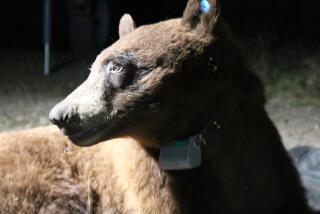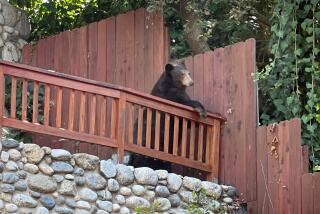All Is Not Lost -- Usually -- if You Face a Close Enounter of the Bear Kind
- Share via
The bear--a large grizzly--was on the other side of a two-lane road in the Canadian Rockies north of Banff. Stupidly, I had left the group I was camping with to take an early morning walk. I didn’t even have my bear bells, the jinglers that one attaches to a stick in hopes the noise will announce one’s presence.
The bear and I were headed in the same direction, the animal with the confidence of a wilderness native, I with an interloper’s temerity that quickly turned to fear. We looked at each other and kept walking. I wondered when it would cross the road for breakfast.
Just then a minivan pulled up. As it slowed, the door opened and a friendly hand--one of my group--pulled me in, leaving the grizzly to eat my dust instead of me.
You would think the experience would have taught me to stay away from bears. Not quite. Unlike snakes, which also scare me, bears are creatures I respect and love. Spotting them in the wild is as stirring to me as seeing Michelangelo’s Sistine Chapel.
I’ve managed to stay safe because I took the time to read the literature about bears provided at most of the national parks I visited. I’ve also read Stephen Herrero’s gripping and informative “Bear Attacks: Their Causes and Avoidance” (The Lyons Press, 2002). I would recommend the same thing for anyone going to bear country, whether a casual day hiker or a back-country pro.
There were about 58,000 grizzlies in North America in 2001, according to National Geographic; there are more than 10 times that many black bears, typically smaller and shyer, roaming from Alaska to Mexico and from California to Maine, Geographic says.
The national parks where bear encounters are most frequent are Yellowstone and Montana’s Glacier. Five people have died of bear-inflicted injuries in Yellowstone since it was founded at the end of the 19th century; in 100-year-old Glacier, 10 people have been killed by bears.
These incidents make for hair-raising stories, like Jack Olsen’s “Night of the Grizzlies” (Homestead, 1996), about an August night in 1967 when two women were killed by bears in separate incidents in Glacier National Park.
A bear encounter is frightening to me because experts advise different responses in different situations. “There’s no cookbook recipe for how to react,” says Darren Ireland, a biologist at Yellowstone.
This spring in the park, Abigail Thomas, a 30-year-old jogger, managed to discourage a grizzly that had her thigh in its mouth by squirting it with a water bottle. The bear walked away, and Thomas escaped with only bruises.
Ireland says experts typically recommend a more aggressive approach, yelling and waving arms to scare the bear away.
Carrying and using pepper spray, which makes breathing difficult but doesn’t permanently injure a bear, is effective for avoiding attacks by black and grizzly bears, says Jim Zumbo, hunting editor for Outdoor Life magazine. Trying to frighten the creature by making loud noises and throwing things often deters black bears.
But when a grizzly charges and makes contact, experts advise people to lie down and play dead. The cannonball position used to be recommended. Now, says David Smith, the author of “Backcountry Bear Basics” (Mountaineer Books, 1997), it’s thought to be better to lie flat on your stomach with your hands folded at the back of your neck. In this position, it’s harder for a bear to roll you over than when you’re balled up, Smith says.
Besides calling for more presence of mind than most people could muster, both approaches mean you must distinguish between black and grizzly bears, which isn’t easy. Contrary to their name, black bears can be brown or blond, the same colors as grizzlies. The best way to tell the two apart is to look for a hump on the bear’s back, which means it’s probably a grizzly.
Moreover, there are different kinds of bear encounters, each calling for assessment and differing responses. If you come upon a grizzly in close quarters, you may be able to stand tall and back away slowly. If, however, the animal is a mother with cubs or is guarding a carcass, grizzlies are seldom as amenable and may charge, calling for the playing-dead approach. If a bear attacks with no provocation as if seeking prey, fight for your life, experts say.
Those kinds of attacks are little understood by biologists and, thankfully, are quite rare. But in May 2000, a woman was killed in the South’s Great Smoky Mountains National Park by a 112-pound female black bear with a 48-pound cub. The animals were blocking the woman’s way on a bridge, so she waded across the stream, but the bears ran her down and killed her.
Like other parks, the Great Smoky Mountains has become more proactive in dealing with problem bears in the last few decades, especially those that get used to eating people’s food and garbage.
Steve Gniadek, a wildlife biologist at Glacier National Park, says the twin killings in 1967, both thought by some experts to have been the work of grizzlies that had been scavenging for tidbits in developed areas, immediately changed the way the park manages its garbage. There and at other parks frequented by bears--Yosemite, Yellowstone, Alaska’s Glacier Bay and Great Smoky Mountains--bearproof dumpsters and trash cans were installed, and visitors are bombarded with information about how to avoid trouble with bears.
In other respects, though, each park takes a slightly different approach to bear management. Glacier Bay National Park can afford to close areas where bears have come too close to people, because it’s so large--3.3 million square acres--with a back country frequented chiefly by a handful of kayak campers.
Yosemite, where the incidence of bears breaking into cars for food hit a park system high in 1998, has addressed the problem by requiring visitors to store in locked bins all items that might attract bears. (Parked cars with food inside can be towed.) In Yellowstone, bears that frequent developed areas are relocated.
Montana’s Glacier has experimented with a new program called aversive conditioning, which employs specially trained bear dogs and noninjurious projectiles to teach bears to stay in the back country, away from people.
Training people about how to get along in bear country is nearly as challenging. Here’s what “Backcountry Bear Basics” author Smith advises:
* Take pepper spray (and figure out how to use it before going into the wild).
* Pay attention to what’s going on around you.
* Make noise so you don’t surprise a bear.
And an additional tip from me: Consider yourself blessed when you do see a bear--but only at a distance.
More to Read
Sign up for The Wild
We’ll help you find the best places to hike, bike and run, as well as the perfect silent spots for meditation and yoga.
You may occasionally receive promotional content from the Los Angeles Times.






